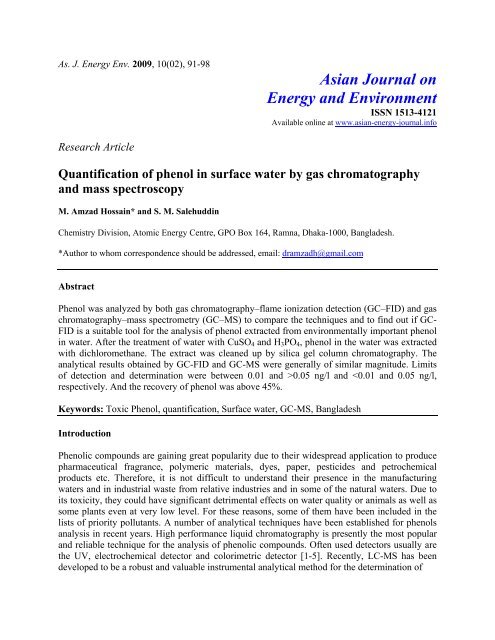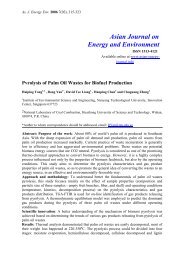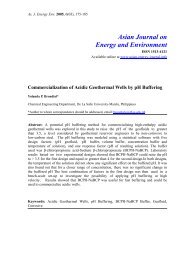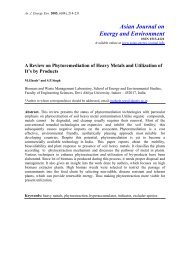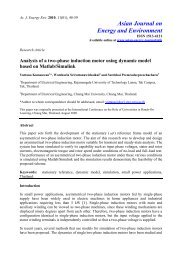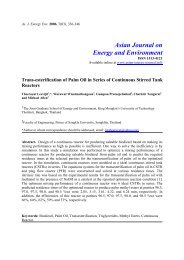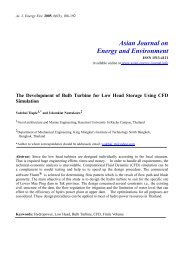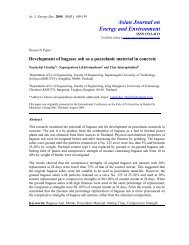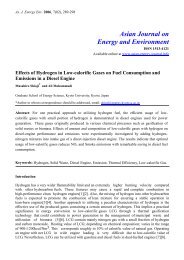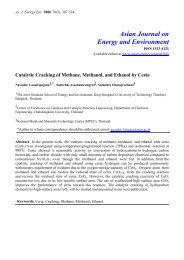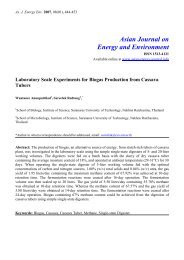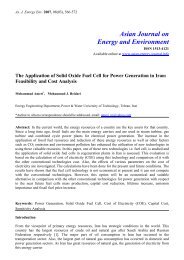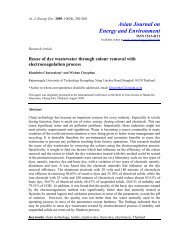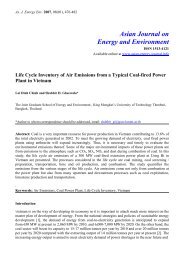Quantification of phenol in surface water by gas chromatography ...
Quantification of phenol in surface water by gas chromatography ...
Quantification of phenol in surface water by gas chromatography ...
Create successful ePaper yourself
Turn your PDF publications into a flip-book with our unique Google optimized e-Paper software.
As. J. Energy Env. 2009, 10(02), 91-98Asian Journal onEnergy and EnvironmentISSN 1513-4121Available onl<strong>in</strong>e at www.asian-energy-journal.<strong>in</strong>foResearch Article<strong>Quantification</strong> <strong>of</strong> <strong>phenol</strong> <strong>in</strong> <strong>surface</strong> <strong>water</strong> <strong>by</strong> <strong>gas</strong> <strong>chromatography</strong>and mass spectroscopyM. Amzad Hossa<strong>in</strong>* and S. M. Salehudd<strong>in</strong>Chemistry Division, Atomic Energy Centre, GPO Box 164, Ramna, Dhaka-1000, Bangladesh.*Author to whom correspondence should be addressed, email: dramzadh@gmail.comAbstractPhenol was analyzed <strong>by</strong> both <strong>gas</strong> <strong>chromatography</strong>–flame ionization detection (GC–FID) and <strong>gas</strong><strong>chromatography</strong>–mass spectrometry (GC–MS) to compare the techniques and to f<strong>in</strong>d out if GC-FID is a suitable tool for the analysis <strong>of</strong> <strong>phenol</strong> extracted from environmentally important <strong>phenol</strong><strong>in</strong> <strong>water</strong>. After the treatment <strong>of</strong> <strong>water</strong> with CuSO 4 and H 3 PO 4 , <strong>phenol</strong> <strong>in</strong> the <strong>water</strong> was extractedwith dichloromethane. The extract was cleaned up <strong>by</strong> silica gel column <strong>chromatography</strong>. Theanalytical results obta<strong>in</strong>ed <strong>by</strong> GC-FID and GC-MS were generally <strong>of</strong> similar magnitude. Limits<strong>of</strong> detection and determ<strong>in</strong>ation were between 0.01 and >0.05 ng/l and
As. J. Energy Env. 2009, 10(02), 91-98 92many compounds <strong>in</strong>clud<strong>in</strong>g <strong>phenol</strong>ic compounds, which possess the merit that they do notrequire the analytes must be volatile and has been considered as an ideal tool <strong>in</strong> analytical,medical and environmental and other fields. However, it is very expensive and needs highrequirement for the operator. Up to now, it cannot be employed as common <strong>in</strong>strument forrout<strong>in</strong>e analysis [6]. Capillary electrophoresis (CE), another alternative analytical technique, hasalso been utilized for the analysis <strong>of</strong> these compounds [7-9]. It can provide many strong po<strong>in</strong>tssuch as high separation efficiency, small sample and electrolyte consumption and rapid analysis.These merits make CE <strong>of</strong> great utility <strong>in</strong> rout<strong>in</strong>e analysis and monitor<strong>in</strong>g processes <strong>in</strong> a number<strong>of</strong> <strong>in</strong>dustrial fields. Moreover, CE is relatively well suited to analysis <strong>of</strong> complex samples, and itallows <strong>in</strong>-capillary concentration such as electrok<strong>in</strong>etic stack<strong>in</strong>g [10], sweep<strong>in</strong>g, dynamic pHjunction, and anion or cation selective exhaust <strong>in</strong>jection-sweep<strong>in</strong>g-MEKC, and dynamic pHjunction-sweep<strong>in</strong>g etc. More Recently, CE has been shown to be a powerful and efficienttechnique and also applied to separate the EPA 11 priority <strong>phenol</strong>s successfully [11-13].In addition to <strong>in</strong>strumental methods, biological methods have been improved to be very useful <strong>in</strong>the analysis <strong>of</strong> <strong>phenol</strong>s <strong>in</strong> food and environmental samples etc. Among these, biosensors are thepopular and ga<strong>in</strong><strong>in</strong>g more attention <strong>in</strong> recent years. A great number <strong>of</strong> biosensors have beendeveloped for the determ<strong>in</strong>ation <strong>of</strong> <strong>phenol</strong>s, which are on the basis <strong>of</strong> tyros<strong>in</strong>ase and perodidase[14-20]. However, these enzymes require strict conditions for keep<strong>in</strong>g and us<strong>in</strong>g as well astransport<strong>in</strong>g to make it <strong>in</strong>convenient to establish and apply these bio-methods. Gas<strong>chromatography</strong>, a very sensitive and reliable analytical tool, especially <strong>in</strong> comb<strong>in</strong>ation withmass selective detector, has been applied <strong>in</strong> separation and identification <strong>of</strong> the <strong>phenol</strong>iccompounds [21]. In this paper, we describe the identification and quantification <strong>of</strong> <strong>phenol</strong> <strong>in</strong><strong>surface</strong> <strong>water</strong> samples supplied <strong>by</strong> Environmental Conservation Management Consultants(ECMC) <strong>by</strong> both GC-FID and GC-MS <strong>in</strong> the way previously established <strong>in</strong> our laboratory.ExperimentalGeneral experimental proceduresChemicalsPhenol crystal, E. Merck (Germany), purity 99.0%; anhydrous Na 2 SO 4, BDH Laboratories(England), purity 99.5%; dichloromethane, HPLC grade, E. Merck; H 3 PO 4 , E. Merck, purity88.0% and CuSO 4, BDH Laboratories, purity 99.0% were used <strong>in</strong> this work.Instrument and operat<strong>in</strong>g conditionsGC-MS was carried out us<strong>in</strong>g total ion monitor<strong>in</strong>g mode on a Varian 3800 <strong>gas</strong> chromatograph<strong>in</strong>terfaced to a Varian Saturn ion trap 2200 GC/MS/MS mass spectrometer. The temperatures <strong>of</strong>transfer l<strong>in</strong>e and ion source were 280°C and 275°C respectively. Ions were obta<strong>in</strong>ed <strong>by</strong> electronionization mode. The VF-5 capillary column (30 m length, 0.25 mm I.D., 0.25 µm filmthickness) was used. A 20% split <strong>in</strong>jection mode was selected with a solvent delay time <strong>of</strong> 3 m<strong>in</strong>.with <strong>in</strong>jection volume 0.2 µl. The <strong>in</strong>itial column temperature was started at 40°C for 1 m<strong>in</strong>,programmed at 8°C m<strong>in</strong> –1 to 200°C and heated until 280 o C at 10 o C m<strong>in</strong> -1 . Injection port was set
As. J. Energy Env. 2009, 10(02), 91-98 93at 250°C. Helium was used as carrier <strong>gas</strong> with a flow-rate <strong>of</strong> 1.0 ml m<strong>in</strong> –1 . Molecular ions weremonitored for identification. Mass range: 40-500 m/z.Sample collectionThree <strong>water</strong> samples were supplied to our laboratory for analysis <strong>by</strong> the EnvironmentalConservation Management Consultants (ECMC) on 3 rd October 2007. They might have collectedthe <strong>surface</strong> <strong>water</strong> from the <strong>in</strong>dustrial area or <strong>gas</strong> field area. Each sample was collected <strong>in</strong> a oneliteramber color glass bottle with 10 ml <strong>of</strong> 10% CuSO 4 stabiliz<strong>in</strong>g agent. The <strong>water</strong> sampleswere stored at 4 o C before analysis.Extraction procedureThe <strong>water</strong> samples were collected from the sampl<strong>in</strong>g spot and <strong>in</strong>stantly stabilized <strong>by</strong> stabiliz<strong>in</strong>gagent <strong>of</strong> 10% CuSO 4 solution. 100 ml <strong>of</strong> <strong>water</strong> sample was extracted twice with dichloromethane(30 and 20 ml) <strong>in</strong> 30 m<strong>in</strong>ute <strong>by</strong> shak<strong>in</strong>g with hand at pH 2, adjusted with H 3 PO 4 (Hossa<strong>in</strong> et al.1999). F<strong>in</strong>ally both the extracts were comb<strong>in</strong>ed and dried with anhydrous Na 2 SO 4 . Then thedried extract was pre-concentrated (1-2 ml) us<strong>in</strong>g Kuderna-Danish (K-D) evaporativeconcentrator. From this concentrated samples, certa<strong>in</strong> volume was <strong>in</strong>jected <strong>in</strong>to the Gas liquid<strong>chromatography</strong> and mass spectroscopy (GC-MS/MS).Clean-up procedureThe cleanup column (i. d. = 1 cm) was filled with cotton <strong>in</strong> the bottom. Activated silica gel (17gm) was soaked with dichloromethane and loaded <strong>in</strong>to the cleanup column (5 cm), which wasthen topped with 1.5 cm <strong>of</strong> anhydrous sodium sulfate. 5 ml <strong>of</strong> dichloromethane was added towash the sodium sulfate and the silica gel. The dried sample was then transferred <strong>in</strong>to thecolumn. The vessel was r<strong>in</strong>sed twice with 2 ml dichloromethane to add to the column. Another60 ml <strong>of</strong> dichloromethane was added to the column and allowed to flow through the column at arate <strong>of</strong> 3–5 ml/m<strong>in</strong>, and the eluent was collected. The collected eluent from the cleanupprocedure was reconcentrated to 0.5 ml with K-D concentrator.Preparation <strong>of</strong> standardCalibration graphs for the samples, treated accord<strong>in</strong>g to the described analytical procedure, weremade us<strong>in</strong>g the SIM mode. Different concentrations <strong>of</strong> <strong>phenol</strong>s (1ng/ml, 100 ng/ml, 250 ng/ml,500 ng/ml and 1000 ng/ml) were used to establish the calibration curve. They were l<strong>in</strong>ear withthe concentration range 1-1000 ng/ml <strong>of</strong> the <strong>phenol</strong>s target.Results and DiscussionIn our previous study [22-23] done <strong>in</strong> our laboratory, it was observed that the –OH group <strong>of</strong><strong>phenol</strong>s is stable <strong>in</strong> aqueous medium at pH 2. The dissociation is suppressed at lower pH and it<strong>in</strong>creases at higher pH values [24]. In our present study, the extraction <strong>of</strong> <strong>phenol</strong>ic compoundshas been carried out at pH 2, too. Phenol is less stable <strong>in</strong> aqueous medium because <strong>of</strong> itsbiological action [25]. So, dur<strong>in</strong>g sampl<strong>in</strong>g for <strong>phenol</strong> and its derivatives from <strong>water</strong> matrices,some authors [22-23] used CuSO 4 as a stabiliz<strong>in</strong>g agent. In our laboratory, one author [25] usedCuSO 4 as stabiliz<strong>in</strong>g agent and produced average recovery results <strong>of</strong> <strong>phenol</strong>s derivatives. He alsoshowed that <strong>in</strong> the absence <strong>of</strong> any stabiliz<strong>in</strong>g agent such as CuSO 4 , the presence <strong>of</strong> <strong>phenol</strong> and its
As. J. Energy Env. 2009, 10(02), 91-98 94derivatives could not be detected after 72 hours i.e. it was completely dissociated with <strong>water</strong>matrices.The quantitative determ<strong>in</strong>ation <strong>of</strong> <strong>phenol</strong> was done <strong>by</strong> external calibration curve method. Thecalibration curve (Fig. 1) was already prepared with known concentrations <strong>of</strong> <strong>phenol</strong> as detailedbelow.Figure 1. Standard Calibration Curve <strong>of</strong> Phenol.Standard curve for <strong>phenol</strong> generated <strong>by</strong> plott<strong>in</strong>g the area <strong>of</strong> five spots vs. the concentration, gavehigh correlation coefficients. The concentration <strong>of</strong> <strong>phenol</strong> <strong>in</strong> three <strong>water</strong> samples (Fig. 2, Fig. 3and Fig. 4) was calculated from the external curve method <strong>by</strong> GC-FID. L<strong>in</strong>ear responses wereachieved for <strong>phenol</strong> <strong>in</strong> the concentration range for <strong>water</strong> samples with the values 9.16 mg/l,9.71mg/l and 10.37 mg/l respectively. Over this concentration range, the l<strong>in</strong>ear regressionanalysis <strong>of</strong> peak areas (y) <strong>in</strong> function <strong>of</strong> concentration (x), calculated <strong>by</strong> least square method,leads to the follow<strong>in</strong>g equations: y = +1.9415e +003x +1.3531e +004 (r 2 = 0.999653) for <strong>phenol</strong>. Theresults obta<strong>in</strong>ed with this method were found to be <strong>in</strong> agreement with the confirmatorydeterm<strong>in</strong>ations done on MS.
As. J. Energy Env. 2009, 10(02), 91-98 95Figure 2. Chromatogram <strong>of</strong> <strong>phenol</strong> compound from <strong>surface</strong> <strong>water</strong> sample 1.Column: VF-5 (l. 30m, i.d. 0.25, film thickness 0.25 µm); delay: 3m<strong>in</strong>; Temperature Program:40 o C(1)—›200 o C (8 o C)—›280 o C (10 o C); Injector Temperature: 250 o C; Split: 20%; Carrier <strong>gas</strong>:He; Flow rate: 1ml/m<strong>in</strong>.Figure 3. Chromatogram <strong>of</strong> <strong>phenol</strong> compound from <strong>surface</strong> <strong>water</strong> sample 2.
As. J. Energy Env. 2009, 10(02), 91-98 96Figure 4. Chromatogram <strong>of</strong> <strong>phenol</strong> compound from <strong>surface</strong> <strong>water</strong> sample 3.Column: VF-5 (l. 30m, i.d. 0.25, film thickness 0.25 µm); delay: 3m<strong>in</strong>; Temperature Program:40 o C(1)—›200 o C (8 o C)—›280 o C (10 o C); Injector Temperature: 250 o C; Split: 20%; Carrier <strong>gas</strong>:He; Flow rate: 1ml/m<strong>in</strong>.Table 1. Concentration <strong>of</strong> Phenol obta<strong>in</strong>ed from three <strong>water</strong> samples.Sl. No Sample GC-FID (Phenol) GC-MS (Phenol)1 Sample 1 9.16± 0.015 mg/L 9.22± 0.045 mg/L2 Sample 2 9.71± 0.065 mg/L 9.88± 0.070 mg/L3 Sample 3 10.37± 0.080 mg/L 10.43± 0.051 mg/LFrom Table 1, it is clear that the concentrations <strong>of</strong> <strong>phenol</strong> <strong>in</strong> three <strong>water</strong> samples are different,although not <strong>by</strong> much. The highest concentration <strong>of</strong> <strong>phenol</strong> was found <strong>in</strong> sample 3 and the lowest<strong>in</strong> sample 1. The similarity <strong>in</strong> results obta<strong>in</strong>ed from both the <strong>in</strong>struments means that they arealmost identical <strong>in</strong> terms <strong>of</strong> sensitivity. So, we can use the comparatively cheaper GC-FID forthe quantification <strong>of</strong> <strong>phenol</strong> <strong>in</strong> <strong>water</strong> for rout<strong>in</strong>e analysis.ConclusionPhenolic compounds are important priority pollutants <strong>in</strong> most countries <strong>in</strong> the world, and manyrelated analytical techniques have been developed for detection <strong>of</strong> <strong>phenol</strong>s. Present work hasbeen done <strong>by</strong> our previously established method (Hossa<strong>in</strong> et al., 1999) for <strong>phenol</strong>s determ<strong>in</strong>ationbased on without any derivative process. Comparable results were obta<strong>in</strong>ed <strong>by</strong> GC-FID and GC–
As. J. Energy Env. 2009, 10(02), 91-98 97MS methods. GC-FID was chosen as an analytical tool for the analysis <strong>of</strong> <strong>phenol</strong> <strong>in</strong> <strong>water</strong>because <strong>of</strong> its reliability and low-cost compared to the other. The experimental resultsdemonstrated that this GC-FID method had <strong>of</strong>fered excellent recoveries and could be employedfor environmental sample analysis. In view <strong>of</strong> the rapidity, sensitivity, simplicity, environmentfriendlynature and so on, the proposed method will be an excellent alternative detectiontechnology for <strong>phenol</strong> analysis, and will be widely employed <strong>in</strong> environmental and other relatedfields.AcknowledgementThe authors are grateful to Sohela Akhtar, Head, Chemistry Division, Atomic Energy Centre,Dhaka, Bangladesh for her constant encouragement and helpful suggestions. They are alsograteful to Mr. Zahidul Islam and Mr. Abbas Ali for their help to preparation the <strong>water</strong> samples.References1. Akasbi, M., Schoeman, D. W., and Csallany, A. S. (1993). Journal <strong>of</strong> American OilChemistry Society., 70, 367–370.2. Angerosa, F., d’Alessandro, N., Konstant<strong>in</strong>ou, P. (1995). Journal <strong>of</strong> Agriculture and FoodChemistry., 43, 1802–1807.3. Bend<strong>in</strong>i, A., Bonoli, M., Cerretani, L. (2003). Journal <strong>of</strong> Chromatography, 985, 425–433.4. Bonnely, S., Peyrat-Maillard, M. N., Berset, C. (2000). Talanta, 51, 709–716.5. Bonoli, M., Montanucci, M., Toschi, T. G., 2003, Journal <strong>of</strong> Chromatography A, 1011,163–172.6. Campuzano, S., Serra, B., Pedrero, M. (2003). Analytica Chimica Acta. 494, 187–197.7. Demianova, Z., Siren, H., Kuldvee, R. (2003). Electrophoresis, 24, 4264–4271.8. Ferapontova, E., Puganova, E. (2002). Journal <strong>of</strong> Electroanalytical Chemistry, 518, 20–26.9. Gaspar, S., Habermuller, K., Csoregi, E. (2001). Sens Actuators B, 72, 63–68.10. Groom, C. A., Luong, J. H. (1997). Electrophoresis, 18, 1166–1172.
As. J. Energy Env. 2009, 10(02), 91-98 9811. Hossa<strong>in</strong>, M. A., Salehudd<strong>in</strong>, S. M., Abed<strong>in</strong>, Z., 1999, Nuclear Science Applications, 8(1-2), 95-97.12. Huang, R., Hu, N. (2001). Bioelectrochemistry, 54, 75–81.13. Kuban, P., Kuban, P., Kuban, V. (2002). Electrophoresis, 23, 3725–3734.14. Liu, S. Q., Ju, H. Z. ( 2002). Analytical Biochemistry, 307, 110–116.15. Mai Anh, T., Dzyadevych, S. V., Soldatk<strong>in</strong>, A. P. (2002). Talanta, 56, 627–634.16. Mart<strong>in</strong>ez, D. Pocurrull, E. Marce, R. M. (1996). Journal <strong>of</strong> Chromatography, 734, 367–373.17. Mottaleb, M. A. Ferdous, M. Islam, M. S. Salehudd<strong>in</strong> S. M. Hossa<strong>in</strong>, M. A. (1999). AnalyticalSciences (Japan), 15, 995-1000.18. Salehudd<strong>in</strong>, S. M. Mottaleb, M. A. Khan, A. H. (1992). Journal <strong>of</strong> Bangladesh Academy <strong>of</strong>Sciences, 1 , 69-74.19. Serra, B. Jimenez, S. Mena, M. L. (2002). Biosensors and Bioelectronics, 17, 217–226.20. Tasioula-Margari, M. Okogeri, O. (2001). Food Chemistry, 74, 377– 383.21. Vaher, M. Koel, M. (2003). Journal <strong>of</strong> Chromatography A, 990, 225–230.22. Watanabe, T. Terabe, S. (2000). Journal <strong>of</strong> Chromatography A, 880, 311–322.23. Wilk<strong>in</strong>son, A. P. Wahala, K, Williamson, G. (2002). Journal <strong>of</strong> Chromatography A, 777, 93–109.24. Zemann, A. Volgger, D. (1997). Analytical Chemistry, 69, 3243–3250.25. Zhang, S. Zhao, H. John, R. (2001). Analytica Chimica Acta, 441, 95–105.


